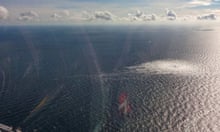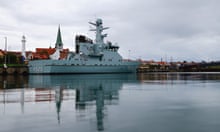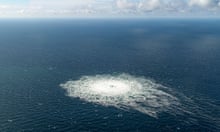It may never be possible to determine definitively whether Monday’s underwater explosions at the two Nord Stream gas pipelines were the work of Russian sabotage, but it is certainly the way to bet.
The incidents took place close to – but just outside – the 12-mile territorial waters of Denmark’s Bornholm in the Baltic Sea, the kind of calibration that might be expected from a state actor mindful of the country’s Nato membership.
What is not immediately clear is how any attack would have been carried out. A submarine targeting the pipelines should have been detected in the Baltic’s relatively shallow waters, where depths rarely exceed 100 metres. But there is no mention of submarines from the countries investigating the incidents.
Nor is Baltic the location where it would make sense to deploy deep-water Losharik submarines, which could be deployed by the Russians to cut the communications cables that run deep under the Atlantic, where the waters have an average depth more like 3,500 metres.
One British military source speculated that mines may have been discreetly laid from a disguised commercial vessel and detonated days or weeks later. That would be an operation that would need to have been undertaken with some care, but not particularly specialised military resources.
This last part is guesswork and western officials were quick to stress on Tuesday that the explosions appeared to have affected Russian-owned assets.
The Nord Stream 1 pipeline between Russia and Germany is 51% owned by Gazprom, the St Petersburg-headquartered energy giant, while Nord Stream 2 is owned by a Swiss subsidiary of the same company. None of those assets would, by this thinking, demand any kind of Nato or other western military response.
But the fact remains that two undersea pipelines have been ruptured in a 24-hour period. They are designed to be tough: each section of the Nord Stream 1 pipeline, the company’s literature says, has a steel case 27 to 41mm thick, in turn surrounded by a concrete coating of 60 to 110mm.
One of the explosions measured 2.3 on the Richter scale, which Danish experts described as in line with a powerful bomb from the second world war. It is not therefore an entirely trivial incident, whose consequences were tellingly being talked up by senior Russian figures on Tuesday.
Dmitry Peskov, the Kremlin’s spokesperson, said: “This is an issue related to the energy security of the entire continent.” However, Nord Stream 2 has never opened and the original pipeline was shut indefinitely for repairs at the beginning of September. So the EU’s claim that there was no security impact was more believable in the first instance.
after newsletter promotion
The episode bears some resemblance to a series of incidents that affected oil tankers in the Gulf three years ago, carefully calibrated to provoke or create fear – but not to do profound damage. In one case, limpet mines were attached to a Japanese flagged tanker, blowing a hole just above the waterline.
If Russia was behind the Nord Stream explosions, Kremlin officials may feel they have undertaken an unnerving demonstration. But on this occasion relatively little was at stake.
Given Russia’s problems in Ukraine, the idea that Moscow would dare to step up by targeting western undersea pipelines and cables in the Baltic Sea and elsewhere remains hard to believe.










